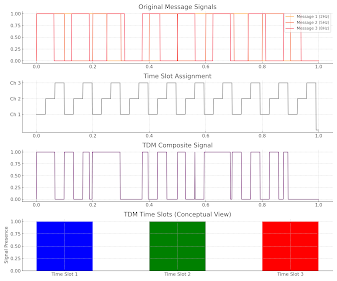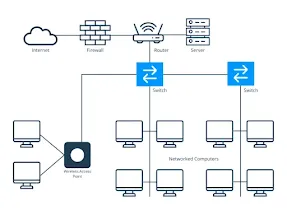✍In the world of telecommunications, multiplexing and switching are fundamental techniques that ensure efficient use of network resources and provide seamless communication between devices. These two concepts play a crucial role in maximizing data transmission, optimizing bandwidth, and ensuring data reaches its destination in the fastest and most reliable way possible. Let's dive deeper into each concept and its techniques.
Multiplexing
Multiplexing is a method of transmitting multiple signals over a single communication channel. The goal is to optimize the usage of available bandwidth and reduce the cost of transmission. By allowing multiple signals to be transmitted simultaneously or in a time-sequenced manner, multiplexing ensures that the limited resources of a communication channel are used efficiently.
Frequency Division Multiplexing (FDM)
Frequency Division Multiplexing (FDM) is a technique where the available bandwidth of the communication channel is divided into multiple smaller frequency bands. Each frequency band is used to carry a separate signal. The signals are modulated to different carrier frequencies, ensuring that they don’t interfere with each other. Each user or data stream is allocated a specific frequency range, allowing multiple communications to occur simultaneously on the same physical medium.
FDM is widely used in analog communication systems, such as traditional radio and television broadcasting. For example, in FM radio, each station broadcasts on a specific frequency, such as 101.1 MHz, and so on, allowing multiple radio stations to operate independently within the same frequency spectrum.
Time Division Multiplexing (TDM)
In Time Division Multiplexing (TDM), the available bandwidth is divided into several time slots. Each time slot is assigned to a different signal, and the signals are transmitted in rapid succession, one after the other. The process is cyclical, meaning that each signal gets the opportunity to use the same channel at different intervals.
TDM is commonly used in digital communication systems, such as telephone networks and satellite communication, where multiple users need to share the same communication channel. A good example of this is ISDN (Integrated Services Digital Network), where each call is allocated a specific time slot on the network for data transmission.
Wavelength Division Multiplexing (WDM)
Wavelength Division Multiplexing (WDM) is a technique used in optical fiber communication, where multiple signals are transmitted simultaneously on different wavelengths of light. Each wavelength acts as a separate channel, allowing for significantly higher bandwidth and more data to be transmitted over a single optical fiber.
WDM is heavily used in high-capacity fiber-optic communication networks, such as those employed by Internet Service Providers (ISPs) and telecommunications companies. Dense Wavelength Division Multiplexing (DWDM) is a more advanced form of WDM, capable of handling hundreds of wavelengths over a single fiber, achieving terabits per second of data transfer.
Asynchronous Transfer Mode (ATM)
Asynchronous Transfer Mode (ATM) is a form of multiplexing that divides data into fixed-size cells, which are small data packets with a predefined length. These cells are transmitted across a network in a highly structured and predictable manner, ensuring that the quality of service (QoS) is maintained. ATM is designed to handle multiple types of data traffic, including voice, video, and data, in a unified manner.
ATM is commonly used in broadband communication networks due to its efficiency in handling both real-time and non-real-time traffic. By dividing the data into fixed-size cells, ATM reduces the chance of congestion and allows for efficient traffic management.
Switching
While multiplexing helps optimize bandwidth usage by combining multiple signals into one channel, switching ensures that data is routed correctly between sources and destinations. Switching can occur in two primary forms: circuit switching and packet switching, each serving different needs in terms of data transmission and network architecture.
Circuit Switching
Circuit switching is a method where a dedicated communication path, or circuit, is established between two devices for the entire duration of the communication. Once the circuit is set up, the data transfer occurs over this dedicated path, ensuring that the entire bandwidth of the channel is reserved exclusively for that communication.
Circuit switching is primarily used in traditional telephone networks, where each phone call requires a dedicated line between the caller and the receiver. The communication path is established when the call begins and remains intact until the call ends. A well-known example of this is the Public Switched Telephone Network (PSTN), where calls were routed through dedicated circuits.
Time Division Circuit Switching
Time Division Circuit Switching is a variation of circuit switching where the circuit is divided into several time slots. Each signal is assigned a specific time slot, and multiple users share the same circuit by transmitting their signals in alternating time slots. This method ensures that each user gets exclusive access to a portion of the channel at different times.
For example, ISDN (Integrated Services Digital Network) uses time-division multiplexing to allocate time slots to different calls or data sessions, allowing for multiple calls to occur on the same physical circuit.
Space Division Circuit Switching
Space Division Circuit Switching, on the other hand, assigns a physical path or channel to each user. In this method, each communication is allocated a specific physical link, such as a copper wire or optical fiber, that remains dedicated to the communication for its entire duration.
This method was commonly used in older analog telephone systems, where each call was routed via a dedicated copper wire from the sender to the receiver. Space division switching can be more expensive, as it requires a separate physical path for each connection.
Packet Switching
In contrast to circuit switching, packet switching breaks data into small chunks called packets, which are transmitted individually over the network. Each packet contains not just the data but also routing information (such as destination address) that helps it navigate through the network. The packets may take different paths and may not necessarily arrive in the order they were sent. Once all the packets reach the destination, they are reassembled into the original data.
Packet switching is the backbone of the internet and modern data networks. It is used by communication protocols like TCP/IP (Transmission Control Protocol/Internet Protocol), which ensures that data can be sent and received over a distributed network of routers and switches.
Datagram Packet Switching
In datagram packet switching, each packet is routed independently. There is no fixed path between the sender and receiver, and each packet is treated as an independent unit with its own destination information. This allows for flexible and dynamic routing, but it also means that packets may arrive out of order or be lost during transmission.
Protocols like UDP (User Datagram Protocol), which is used for real-time applications like video conferencing or online gaming, rely on datagram packet switching.
Virtual Circuit Packet Switching
Virtual Circuit Packet Switching, on the other hand, establishes a logical path between the sender and receiver before data transmission begins. This virtual circuit ensures that the packets will follow the same path and be delivered in order. This type of packet switching is more reliable and ensures that packets are received in the correct order, making it suitable for applications that require guaranteed data delivery, such as TCP.
Message Switching
Message switching is an older switching technique where entire messages (rather than small packets) are stored and forwarded between switching nodes. In this system, the message is temporarily stored at each intermediate node until the next node is ready to receive it. This process continues until the message reaches its destination.
While message switching was used in early telecommunication systems, it has been largely replaced by packet switching due to its inefficiency and delay. However, message switching is still found in some legacy systems, especially in applications where entire messages need to be relayed across multiple points.
✍In telecommunications, both multiplexing and switching are essential for effective communication. Multiplexing enables the efficient use of available bandwidth by allowing multiple signals to share a common channel, while switching ensures that these signals are routed efficiently and accurately between devices. Techniques like FDM, TDM, and WDM are used for multiplexing, while circuit switching, packet switching, and message switching help direct the flow of data across networks. Each method has its specific use cases, from analog broadcast systems to high-speed internet communication, ensuring that networks operate smoothly and efficiently at all times.





















